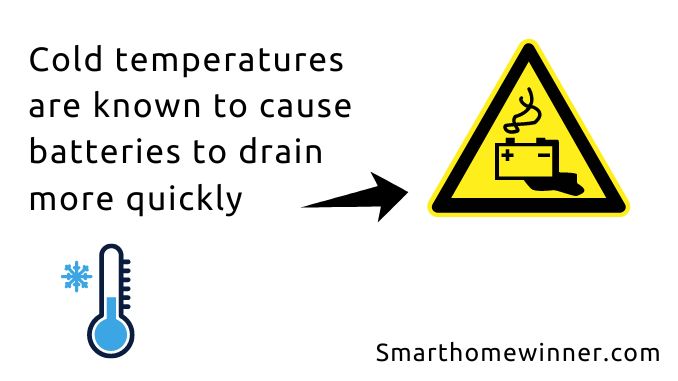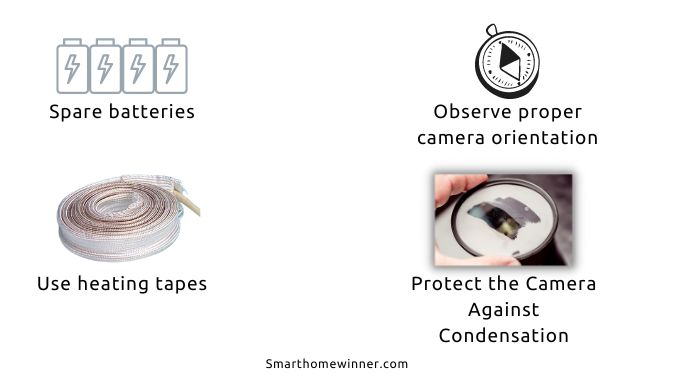If you live in a region where temperatures get significantly low during the winter, one of your biggest concerns should be about the performance of your cameras during winter. After all, no one wants to invest in cameras just to have them freeze up when they are needed the most.
Blink cameras have gained popularity in the last few years thanks to their incredible design details, impressive performance, and lasting batteries. They are also engineered to be weathertight, which helps ensure performance, even when temperatures get extreme. However, like most fixtures, they have limits.
Sometimes, your Blink cameras may stop working, especially when temperatures fall below zero degrees.
So, what causes Blink cameras to stop working in the cold? Is there a way to optimize their performance in cold weather?
This post will give insights into why your Blink cameras might stop working in the cold and how you can address the issue.
Blink Cameras’ Operating Temperatures
| Blink Cameras Model | Temperature |
| Blink Indoor/ Mini cameras | 32°F and 95°F (0°C to 35°C) |
| Blink Outdoor cameras | – 4°F and 113°F (– 20°C – 45°C) |
Since Amazon acquired it, Blink has strived to make its cameras superior in every aspect. Talking about operating conditions, the Blink cameras are usually engineered to handle cold weather and elements.
Precisely, the Blink Indoor and Mini cameras, which are designed for indoor use, operate best between 32°F and 95°F (0°C to 35°C).
On the other hand, the Blink Outdoor cameras, the models designed exclusively for outdoor use, operate best between – 4°F and 113°F (– 20°C – 45°C), meaning your cameras will work perfectly during winter and summer.
Interestingly, the cameras come with temperature sensors that indicate when the surrounding temperature is too high or low for the camera to function.
Understanding The Impact of Cold Temperatures on Your Blink camera

All Blink cameras have operating temperature ranges, with outdoor cameras having a wider range. And while these cameras are designed to handle low temperatures, when the temperatures fall below – 20°C, the cameras might stop working, necessitating an understanding of how cold temperatures affect their performance.
Well, cold temperatures are known to cause batteries to drain more quickly. Since Blink cameras are battery-reliant, cold temperatures will cause them to run out of power, leading to abrupt failure.
Besides, low temperatures can result in condensation. When condensation forms on the lenses, the layer of milky frost blocks your camera’s view, keeping you from monitoring what is happening on your property. The water droplets can also get inside the camera, potentially damaging the circuitry.
How to Properly Care Your Blink Camera in Cold Weather
Cold temperatures can wreak havoc on your Blink cameras, which can be a big risk if you are away on a trip. Interestingly, there are ways to keep your Blink cameras working outside the usual temperature ranges.
Consider the following tips and keep your camera safe and functional in cold weather.

Have spare batteries
The battery is the major pet of your camera that is affected greatly by bad weather. Notably, a slight drop of about 10° Celsius in temperature can cause a big mess on your battery life, reducing this life to about half its expected lifespan. Extra batteries can save your camera from losing power, as you will always have enough to replace the older ones.
Observe proper camera orientation
Mount cameras under awnings to prevent direct contact with harsh weather. With awnings, you can partially add moisture absorbers so that the high humidity does not affect your camera.
Use heating tapes
Heating tapes are viable solutions to keep cameras safe in cold weather. They are usually wrapped around the camera surface and function by ensuring the camera’s surface temperature is constantly warm throughout the winter.
Protect the Camera Against Condensation
If water gets into the camera holes, it will definitely damage the interior parts. The state gets worse in cold weather as air condenses inside the camera. Consider some of the most appropriate methods to keep your Blink camera safe from the risks of condensation in cold weather.
How to Fix Common issues with Blink cameras in cold temperatures
If your bink camera is not working in the cold, find out the underlying problem and consider the tips below to troubleshoot.
Check the connection
Before complaining about your Blink camera not functioning, it is important that you first check if it is powered and connected online. If not, consider the basic steps of powering your camera.
Replace batteries
In cold weather, battery power will get low very fast. Replacing the batteries after a short period will help keep the camera functional.
Restart the Blink camera
When the camera has new batteries protected from condensation but still fails to work, the best thing to do is restart the camera. Restarting will refresh all the applications and features of the camera, making it work efficiently.
Performance of Indoor and outdoor Blink cameras in cold temperature
Blink cameras function well in a specific range of temperatures and connections. Indoor cameras ate designed to operate effectively when the temperature ranges from 32 degrees to 95 degrees Fahrenheit. The outdoor cameras operate well in a temperature range of -4 to 113 degrees Fahrenheit.
When exposed to extreme heat, the battery life of both cameras is greatly affected. Too much cold and extremely cold temperatures also affect the battery and functionality of Blink cameras. Indoor cameras are at high risk of temperature effects than Outdoor cameras.
How to extend the lifespan of your Blink camera in cold weather
To extend the lifespan of your Blink camera in cold weather, you have to protect it against the drastic effects of cold.
Find ways to ensure your camera is under fair temperatures by insulating the camera area, covering the camera surface, using heat tapes, and preventing moisture from sipping inside the camera.
Also, consider replacing batteries and keeping the camera always connected. If you are not in a position to protect the camera against cold weather, you can also bring it indoors until the temperature rises.
Rember To Monitor your Blink camera in cold temperatures
You can monitor your Blink camera in cold weather by activating the temperature sensor. Other than the Blink mini, all other Blink cameras come with an internal sensor that monitors temperature.
You will get alerts when the temperature is getting too low or when it is getting high. If it s getting low, consider the tips above and protect your camera.
Conclusion
Blink cameras make smart home monitoring a reality. However, there are only sometimes strong to work in all weather conditions. The camera and its battery are greatly affected by cold weather. Therefore, you need to consider protecting outdoor cameras in cold weather to improve their lifespan.
